
RoadtripPart 7: the journey home |
Part 1:
first leg to Hybridfest
Part 2: local Wisconsin tourism and slightly beyond Part 3: South Dakota, Black Hills Part 4: bangin' around the Northwest Part 5: meandering east toward Denver Part 6: doing tech at Denvention (aka Worldcon) Part 7: the journey home |
| With Worldcon behind me, it was time to get the heck out of Denver. My area host kindly rescued me from the doorstep of the Sheraton and we retired back to his place to hang out for a little post-con recovery before I headed off for whatever the next little adventure would be. |

|
It had been sprinkling a little bit that day and cleared up in the afternoon, and when I got back to the car I noticed that the black stripe on the hood exhibits very different water-retention characteristics than the base paint. Weird. |
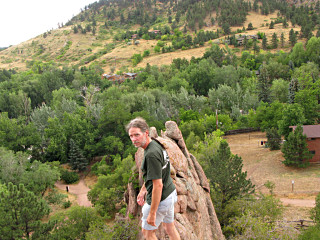
|
I soon reached the Boulder area and noodled my way through it, and just at the western edge of town where the mountains begin to rise up I found Red Rocks Park, which must be only one of *hundreds* of so-named places since this isn't the park farther to the south with the big and much more famous Red Rocks amphitheatre. But this park is a nice little walkaround area with a narrow ridge of similar red sandstone upthrust in the middle -- so narrow that in the ten seconds I had to get out in front of the camera on the delay setting here, I wasn't entirely sure I could turn fully around without losing balance. |
|
Boulder seems to be another progressive region in general. I saw lots
of people running around on bicycles or in hybrids, and a number of clueful
high-tech companies have sprung up there over time. But the whole area has an
oddly contrived feel about it, like human civilization has forced its way in
and built big malls and tracts of McCondos just to convince itself of having
something like permanent infrastructure by louder marketing. Obviously when
an area is initially settled something has to entice more people to move
in and help expand it, but here it feels like everything has hidden cheeziness
and any "permanence" is all a giant falsehood. In contrast to the surrounding
mountains, that's certainly true of any human effort -- perhaps that was just
standing out more to my mind now, after spending so many days seeing and
thinking about my surroundings in timeframes spanning millions of years.
Colorado also has a bit more proximity to Vegas, the epitome of fragile human
habitation temporarily carved out of a merciless desert, and I'm sure some of
the design and construction techniques and even materials-supply spill over.
No, I can't explain or express this feeling any better than that. Perhaps it was also because so much of what's there is relatively new construction. But just looking at the "civilization" around me I got a much stronger feeling of "this just doesn't belong here" than I do back in New England, where towns and features generally seem more, uh, integrated into their surroundings with more years of existence to back up the idea of belonging. |
|
My next hosts had just come back from
Def Con 16,
and I got to hang out with them for the next day and a half and talk about
network security, smartcards, RFID, and integrated device-management
frameworks in between going through some of my pictures and trying to help
debug their somewhat ailing satellite link. Lots of scary stuff comes out of
the hacker community every year, with one of the major bottom lines being
"stop increasing complexity at the expense of thinking it through carefully",
but the industry keeps turning a deaf ear to that in favor of getting more crap
out the door sooner. The human factor, the primary weakness, creeps in at
almost every phase of product lifecycle -- developers who have no idea how to
code securely in hostile environments, marketers with inflated claims of
protection and robustness, implementors who insist on using the latest
spiffy but sadly misguided featurization, and the end users who just buy
into the resulting mess without applying any skepticism as to what the
results might be. Not to mention the almost complete lack of regulatory
standards that should hold PEOPLE accountable. So really, next time you
realize your Windows box [or maybe the one in a remote data center serving
your "cloud"?] got compromised by some Javascript exploit and sent all your
financial details to a mysterious site in the Ukraine, don't come crying to
me. That's my take on the computer security industry these days -- as hard as
some of us tried to help make things better over the years, the unwavering
complacency of the sheeple and purely reactive nature of anything that ever
actually gets fixed has just soured the whole experience.
But there's still a lot of cool stuff happening, and some promising development efforts in secluded labs here and there that could help bring improvements down the road. It always seems to be a grassroots effort that has to work hard for any public attention, just like in the renewable energy industry. And as hopeless as it may or may not seem, it was good to spend a couple of days just soaking in thought about it all. |
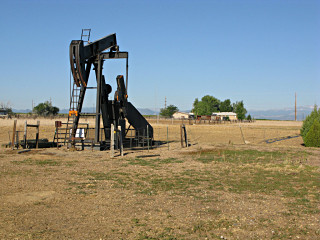
|
The folks here also happen to have one of those "horsehead" oil-pumping rigs in their backyard, so in the morning I walked out to it to *finally* get a closer look at one of these things. |
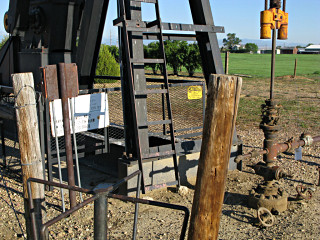
|
The interface into the ground is possibly the most interesting part, and certainly sprouts a lot of complex plumbing. |
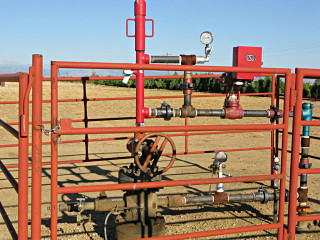
|
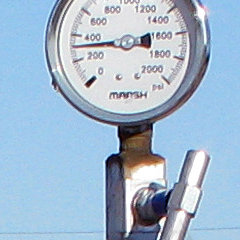
|
|
A few feet away from the pumpjack was another smaller rig, with a similar
wellhead but without a pump rod, most likely for extracting natural gas
instead. It appears to handle some fairly scary pressure levels.
The fencing is to keep cattle from banging into the works and breaking things -- I'm sure a sudden 300-PSI blast of sour gas from a broken pipe wouldn't be a recipe for bovine bliss. | |
|
It had been fun hanging out in the area and seeing snippets of how its
residents live, but with another two-thirds of the country still ahead of me
and at this point over three weeks on the road, it was feeling even *more*
like high time to get my ass home.
I headed out the next morning figuring to take a "shortcut" down what looks like an eastern spur of I-70 past the airport, which turned out to be a huge mistake. It's not exactly an interstate stub -- it's called "state highway 470", a fairly new road, and forms a partial beltway around the eastern side of Denver. There's the nasty surprise: the project was recently begun to help facilitate airport access, and is another one of those way-overpriced privately-managed toll roads on which they nail you coming or going. In my case, since I jumped on from the north and wanted to go *past* the airport to get to I-70, they got me both coming *and* going and it cost 4 bucks to go all of ten miles. Once I was on the damn thing there wasn't really any way to bypass the rest, since there aren't any other roads [by design]. So here's a heartfelt ..|., from my wallet to E-470 and their for-profit tolling structure designed to screw all the people who *aren't* headed for the airport, especially with few if any warning signs at the on-ramp entrances. |
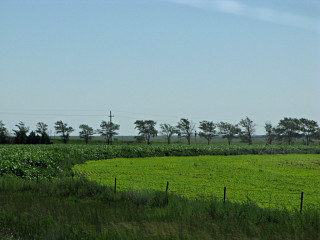
|
The wind slowly swung around from westward to southward, gradually becoming
a hindrance again rather than a help. So much for pushing 70 MPG! There's a
rear-quartering
transition region
where side winds start reducing fuel economy even if they're still
coming from slightly to the rear.
And it was pretty relentless. As I neared the Kansas border, the trees were giving that obvious sign that eastern Colorado desperately needs windmills. |
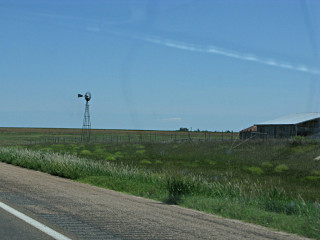
|
And I don't mean like this, either.. |
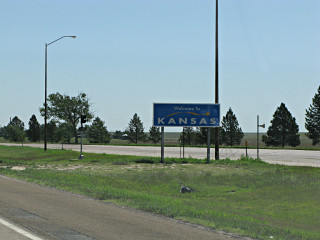
|
I reached the Kansas line right around noon, showing 66.9 MPG -- from a combination of the mostly-tail wind and the fact that I had descended slowly from 5200 feet down to 3800 here. |
|
A sign said there was free coffee at the welcome center -- I was of course all
over that, so I pulled in, chatted briefly with a *very* cute woman with a
black Prius in the lot, and wandered in to fill my mug. The desk folks gave
me a little flyer showing all the points of interest I could go see across
the 400-some miles of their proud state. Ironically, even though the
"Monument Rocks"
sounded somewhat interesting, I skipped that and the only *really* intriguing
thing I would find in Kansas was not listed in the flyer at all.
One thing I found quite entertaining is that the rest-stops in Kansas have RV parking loops and dump stations. Really catering to the passin'-thru vacation crowd, I guess. |
|
As I stood there looking around another car pulled in behind me, driven by
another guy who wanted a picture of the turbine array. We got to chatting
and preaching to each others' choirs, and as we stood there a pickup truck
turned in and went on by us, sporting a "Power Partners" logo with a windmill
outline, and dust-plumed its way up the gravel road out of sight. Aha, I
thought, that must be part of the workforce that will hopefully be bringing
these puppies online soon! So when I got back in the car I also headed up
the gravel road, following where I thought the pickup might have gone. I
had a ton of questions I needed answered at this point, and maybe someone
who actually lays hands on this gear would know some of the answers.
Y'know, like the little kids who pester the construction workers but actually ask the *good* questions might grow up and become architects someday. |
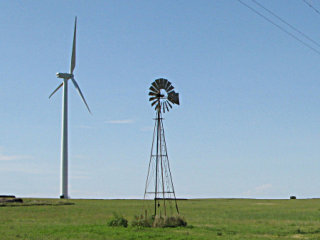
|
The field across from the worksite presented a nice juxtaposition of the old and the new. All I needed was a model T sitting across the road from me... |
| The more I looked into this stuff post-trip, the more rays of hope I found in terms of the number of renewable energy projects that are going out there in one form or another. While I didn't find out exactly who was behind this particular effort in Kansas, in the process of groping around I found some large and encouraging lists [PDF] of other projects either completed or in progress. |
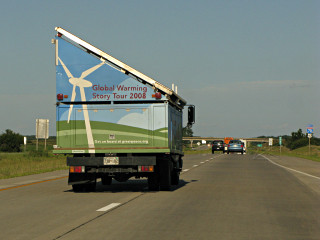
|
This odd item hauled past me at some point. From Maryland, interestingly enough.. No idea what shows they might have been bringing this around to. |
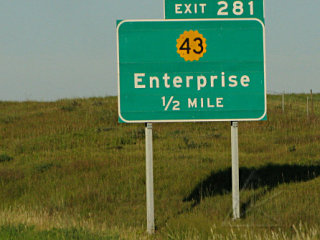
|
One for the Trek fans in the room... |
|
On passing by Topeka, the elevation was down to 850 feet as I was nearing the
rivers. I made it just past Kansas City [both of them, there are technically
two] and across the Missouri River before planning to call it a night. At
the next little "knot of civilization" where travel plazas cluster around a
secondary highway interchange, I pulled in for a quick bite of food and as I
mulled my overnighting options I noticed a woman a couple of parking spaces
over crouched down and peering under her car in an odd way.
It was a small wagon, Subaru or something, with stuff piled high in the back. I offered a flashlight and she went into how she had been hearing a funny scraping noise, and sure enough some of her plastic fender-liner had become detached underneath the front of the car and was hanging loose and banging around. I saw where a couple of the little retaining pins had come out, dug around in my own supplies and came up with a little bundle of "telco wire" and band-aided up a quick fix for her so the plastic wouldn't wave around in the breeze, suggesting that she have a more official repair done next time she had the car into someplace. She was all over the place grateful for this, and insisted on giving me some of a tasty apple-based dessert she happened to have along with her! Turned out she was headed for Massachusetts too, in the process of moving to the Kripalu center to live for a while. Funky. An old housemate of mine was big into that place too, and may have eventually gone off to become part of their organization after I lost track of him; the place has obviously grown quite a bit in popularity since then. The Berkshires are certainly a lovely area to hang out in and much closer to home, even if none of the hills are much over 2000 feet. Home. Right, that's where *I* was trying to get to. But no more tonight for me, as I'd already done over 12 hours that day. |
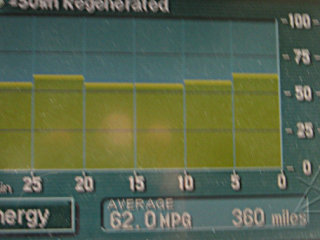
|
I was right. But despite the next couple of hours of fairly blasting rain, I managed to keep fuel usage reasonably in check. |
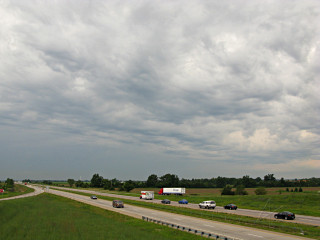
|
After a while I managed to outrun the storm cell, scooting out eastward ahead of a total *wall* of water I'd just slogged through. I thought I'd be stuck under that bad boy all day. |
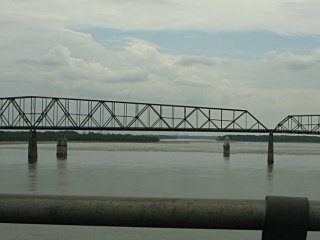
|
Not like any of it mattered today, because within another half-mile a big slow
backup had formed and everyone was crawling, all the way down to and across
the bridge over the Mississippi. Perhaps there was an identifiable
explanation for it?
[*Note: the other pictures at the
"oops" site are well worth a look!]
Anyway, I had plenty of time to nab another shot of the river and close that
little logical loop in terms of trip milestones, however dull today's light on
it was. Down to 600 feet ASL again. Traffic in the other direction was fine,
moving right along and making the whole bridge bounce up and down in an
amusing way as I sat there. I know at least one friend who's leery of bridges
in general who would have been absolutely terrified by this.
Since I didn't actually go into St. Louis itself, I didn't go see the Gateway Arch. Next time through, maybe. |
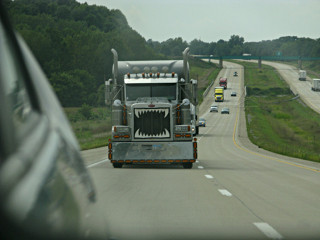
|
The rest of the run to Indy was relatively uneventful, albeit with improving
weather through the remainder of the day and some lucky dodges around the
lingering storm cells.
While this particular truck swung out to go around in a reasonably early timeframe, there was something amusing about this scene as it formed that I had the urge to get a picture. It again recalls that "Duel" feeling -- something about the angles and the lean, the "chicken truck" lights and doodads attached all over, the hill going away behind, the light, and the hint of framing from the rearview and the side of the fleeing car-about-to-be-prey just lends an overall "oh shit" feel to the shot that really tickles me. Unfortunately it does rather express the attitude of many of the trucks passing through Indiana and Ohio, though, especially on the secondary highways like US20 where they're trying to bypass all the I-80 tolls and still make up time. |
|
One ironic thing I've noticed about some tailgating trucks is that many of them are now sporting a proximity-warning device such as the VORAD units which warn of close vehicles to the right-hand side and/or the front of a truck where drivers can't see. The front sensor usually looks like a small black rectangle of plastic embedded in a hole through the front bumper. [I.e. this truck doesn't have it.] What I can't understand is when I do see one of those units, right up close and personal behind me -- the readout in the cab must be *screaming* at the driver at that point, and it doesn't seem to help. I'm sure their dispatchers would take a dim view if they found out that drivers were turning such warning devices off or ignoring them. | |
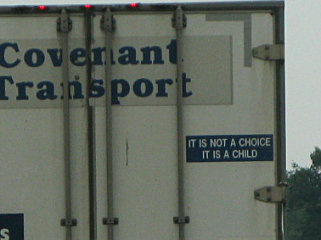
|
But even the trucking company managers aren't perfect, as they can find a few
other creative ways to offend the general public. This has nothing to do with
the business of shipping and logistics, and the back of a commercial trailer
really isn't the place to express anyone's political opinions. Personal
vehicles, sure, say whatever you want on a bumper sticker, but keep it
separate from getting a for-profit job done.
Besides, they're wrong. So neener. |
|
I eventually arrived in Indianapolis and found my next host's building. She's
a med-student and recently
published author,
and lives in a cozy little apartment right in the middle of downtown. This
made parking slightly problematic, since everything is metered, but we decided
that given the enforcement hours listed on the meters that I was okay in a
spot in front of the building for the night and that if I took off early in
the morning when she got up for class, I'd be fine. We wandered out past a
few artsy little shops for a pleasant dinner and chat, took a quick tour around
the local library, and went back to meet up with her brother who was also in
town. The area is pretty nice, not looking particularly run-down or trashy as
one might expect in the center of a major city. The three of us talked for a
while and I gazed in wonderment at the quantity and size of her medical texts,
and then we carved out our little spots to sleep and drifted off.
I bid my host farewell and escaped town long before the meter-minders would come along, continuing eastward into a fairly nice morning. Everything was fine until I got slightly screwed up around Columbus OH and managed to take the wrong offshoot from its little beltway, sending me eastward instead of the northeast I wanted to go. It was time to get fuel anyway, so I hopped onto a fairly obvious secondary highway to recover, tank up, and noodle my way northward between the two legs of interstate. |
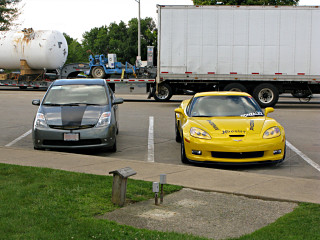
|
Sort of a "polar opposites" shot, at least in the realm of intent, in a
rest stop somewhere along I-80 in PA. The owner of this yellow
performance-engineered zippy thing [who I never saw in the brief time I was
here] is evidently a Philadelphia-area SCCA member, and probably takes this
out autocrossing many weekends. I even found at least
one picture
of the same car from the PhillySCCA website.
It looks like it would be really easy to do a radiator-blocker on this one.. |
|
I continued on through Pennsylvania until later in the evening, managing
to avoid most of the
axe-murderer Schneider drivers
that seem to plague its roads in particular,
and pulled into some random motel parking lot conveniently blanketed with a
nice solid WiFi signal from inside. I posted a quick update to CleanMPG,
reflecting the relative surreality of actually being within another day's
striking distance of HOME and how nice it was to be clear of treeless
prairies, and grabbed a bit of relatively undisturbed sleep.
I was up and rolling again at 7 the next morning. The rest of the trip would be a relative no-brainer: reverse the "standard west" route, hopping across the PA ridges through Scranton and onto I-84 up through CT and MA. The last push! |
|
But I really do mean it about I-84 through NY and CT, which I've made other
observations on in the past. As one of the major conduits between rude New
York me-first buttheadedness and Boston-style surgically directed malice, it
can turn into a real traffic meatgrinder sometimes and I often seem to hit it
at the more, uh, interesting times. I especially offer the part through
western CT as a real brute-test for any serious Prius driver, who's already
got a handful to pay attention to. It is definitely inhabited by numerous
raging apes, it's bumpy, has several tight 50-MPH or less safe-speed-rated
curves, lots of ups and downs, lots of on/off ramps and lanes that suddenly
become exit-only with little warning, a few very short "slow vehicle" lanes
uphill that aren't long enough to be worth using [not that you're able to
tell enough in advance] but that some drivers tend to use for *passing*, and
a generous helping of curves with a notably uneven turn radius. And a metric
assload of traffic sometimes, spacing itself at a car length or less in many
cases. The absolute *last* thing you want to add to this toxic mix is having
to worry about instantly and radically responding to what the car ahead is
doing, so the first thing to do is get that gap ahead opened up nice and wide
and not worry about anyone using it to do their own routing -- if someone uses
the space briefly to get where they need to be, you've helped them, and by
extension yourself just a few seconds later.
Naturally, the assaults began as soon as I started mixing it up in this vehicular mosh-pit, and the first Porsche to violate my personal space responded to my indications of resistance by pointedly zooming up to the next car ahead of *him* in the left lane and tailgating it mercilessly until it moved over. Like that was some kind of retaliatory show against me, right? Brainless. For the remainder of this run I decided to simply wedge my "following distance" sign [see below] into the window slot next to me and leave it there, as sort of an experiment to see if its presence might help moderate the spacing in the conga-line going by me on the left. This was apparently a total failure, as it continued being as tight as ever over there. If I had been relatively relaxed over most of the trip in general, this is where the highest muscle stress began to creep in, and my right knee began to feel "torqued" for the first time over all that driving. Why? Because maintaining smoothness and spacing through this stretch required tigher control than just about anywhere else, even those twisty mountain highways. That tends to build that particular type of muscles-fighting-muscles tension that's hard to notice creeping in, as one is occupied with fractional-inch pedal movements adapting to the rapidly changing energy-envelope needed to navigate the road. Perhaps I was just being more prone to it on this last stretch, not sure. But one clear prevailing benefit of keeping the large gap ahead was that nobody cut *me* off, they all had plenty of room. Several of them suddenly dove for exits out of the middle lane, and I had already provided the hole through which they could. No loss to me, they were gone in another instant and didn't endanger anyone else in the process. When such maneuvers occurred farther ahead and I could see them, they were heralded by a little explosion of surrounding brake lights -- to celebrate the fact that someone couldn't plan ahead better, or something. Bah. Really, one should *never* have to use brakes on an open interstate unless there's a real problem or a huge hill. |
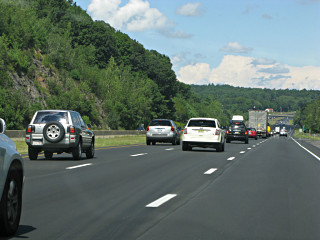
|
The rat-race continued through and well past Hartford and eventually began
to thin out just a little, but still not what you'd call tranquil. I had
been so intent on all the kinematics of this that I totally forgot about my
free coffee sitting right there.
I think that's the infamous, always-seen-from-84 "Red-Art's Service" up ahead on the hill. As much of a New England roadside institution as Rein's Deli. |
|
Somewhere in the northern Connecticut hills, I hove to briefly in a rest-stop
for a quick leg-stretch. As I was starting to move again I wound up following
a truck out of the lot, but hung back as I saw another situation developing
right in front of me -- the guy kept accelerating into the merge as another
truck came barreling down the hill behind us with nowhere else to go. There
was a loud air-horn BLAAAAAT! and the one on the highway briefly locked his
trailer brakes and managed to find a small half-gap to the left and swerve
around. The entering truck would have had plenty of room by waiting another
moment; instead, he almost bought it that day.
But no matter, I saw it coming and was nowhere near it. In another few miles I got a strongly surreal feeling while passing the big WELCOME TO MASSACHUSETTSsign. OMFG. Almost home. | |
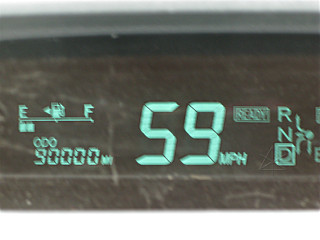
|
The car turned 90,000 about 20 miles out, amusingly in right about the same place it had turned 50,000 and I had gotten a picture of that too. I wonder where 100,000 will happen? |
|
At about 3pm that afternoon I came quietly drifting down the street I hadn't
seen for a month and observed that the house was still standing. I pulled
into the driveway, got out of the car and walked a short distance away,
turned around, and waited.
And waited a little more. But the "Bluesmobile" routine I was half-expecting, with the doors falling off and all four tires going flat at once and smoke leaking out from under the hood, didn't happen. This car, in fact, could be thought of as "just nicely broken-in" especially given its fuel-economy performance that day. 64.8 on arrival, according to the screen. The rest of the afternoon was spent rebooting the homestead, unloading all the trip detritus, and doing the final data-transfer dance. |
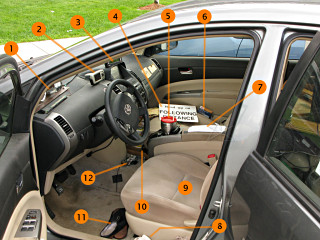
|
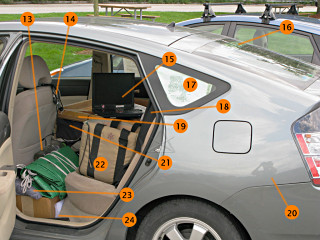
|
| A quick look at the running setup... | |
|
|
Not shown, stashed in the back and elsewhere:
| |
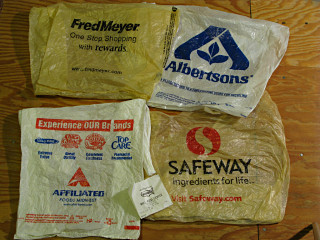
|
It was interesting to visit the various grocery chains that aren't in my home area. I already knew about Safeway and Albertson's, the latter being the poster child for privacy invasion; the other two I had never heard of before. |
|
Next would come the massive picure-processing and storyline organization
project. The author in Indianapolis opined that I should just write a
book ... except that it wouldn't have quite the same flavor and clickable
big-pictures that a set of webpages does. And really, how many rundowns
of "what I did on my summer vacation" would you actually be willing to pay
*money* for?
As mentioned before, there were quite a few odd coincidences throughout the trip, some visual and some otherwise, that were never captured in sufficient detail. Perhaps they should have been, or perhaps they were just completely trivial. I recall one particularly amusing juxtaposition in Missouri, of a "Jesus loves you" billboard and a large "Adult bookstore" sign seen from the highway. I almost went back for that one. Next time, or maybe someone else already has. There were some other bits of followup as well. About a month later I had an interesting conversation with a logistics safety manager for Wal-Mart, because I was curious, which then got written up because it seemed so relevant. And later in the year, some of my hypermiling acquaintances launched a 48-state challenge trip around the country. After surviving this length of trip of my own with that many hours at the helm I could really understand what they were up against. |